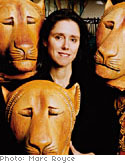Oprah Talks to Julie Taymor

The Tony Award-winning director and artist—and the roar behind Broadway's The Lion King—pounces on the subject of creativity: its spark, risk, and heart-stopping power.
A few years ago I experienced one of the most unforgettable moments in Broadway theater—the opening scene of The Lion King . In the days leading up to the performance, my best friend, Gayle, who had waited a year to get 15 tickets for her kids, her sisters and their families, and all their children, kept telling me, "Get there on time, Oprah! Don't be late!" And she was right: The animals and characters parading down the aisles during the most magical, fantastical opening I've ever witnessed are enough to leave any audience near tears. I left the show feeling more alive. After the performance I remember thinking, "What person could have conceived all this?"That person is Julie Taymor, the director who brilliantly elevated Disney's 1994 animated film into a theater performance in which actors, in full view of the audience, operate life-size animal puppets. Her imaginative twist paid off: Since its Broadway debut in 1997, The Lion King has grossed more than $150 million and garnered six Tony Awards—including the first Tony to go to a woman for directing a musical.
Taymor's stellar career as an artist, director, and designer began long before The Lion King . By age 7 she was staging backyard performances for family and friends in her hometown of Newton, Massachusetts. At 10 she started working with the Boston Children's Theatre. In the coming years, her passion for folklore, mythology, mime, and theater would take her to Sri Lanka, Paris, and Indonesia, where, for four years during her early twenties, she lived in a dirt-floor compound with no running water, electricity, or telephone. While there, she created and directed a trilogy called Way of Snow , which explored, among other things, the tensions between traditional Indonesian society and modern influences. The performance included puppets and masks that Taymor carved herself using wood from a tree outside her house.
Over the past two decades, Taymor's experiences abroad and her trademark sophistication have shaped her award- winning productions. Among the works she included in her book Playing with Fire (Abrams) are The Haggadah (1980), Liberty's Taken (1985), Shakespeare's Titus Andronicus (1994), which Taymor later directed as a film starring Anthony Hopkins and Jessica Lange, The Green Bird (1996), and Juan Darien (1996), for which she received a Tony nomination for best direction of a musical and best scenic design. As the famed composer and lyricist Stephen Sondheim has said: "Julie is uncategorizable as an artist."
Taymor and I met one evening at her Manhattan home, a tenth-floor loft that she shares with her partner and collaborator, composer Elliot Goldenthal. The space reflects her creative genius: A mask she carved for the 1984 production of The Transposed Heads is suspended above a red spiral staircase, an alabaster bust from Juan Darien perches on a stool alongside a piano, a hallway leading to Elliot's music room bears a poster from The Lion King , with the words UNLIKE ANYTHING BROADWAY HAS EVER SEEN at the bottom.
As she spoke, often using her hands to amplify a point, I could see she is confident and fearless—someone who has never allowed others to put a box around her. During our talk it became clear that the creative force she is now, at age 48, has everything to do with the priceless gifts her parents gave her—the freedom to create her own life and an unshakable trust in herself.
Start reading Oprah's interview with Julie Taymor
Note: This interview appeared in the November 2001 issue of O, The Oprah Magazine.



